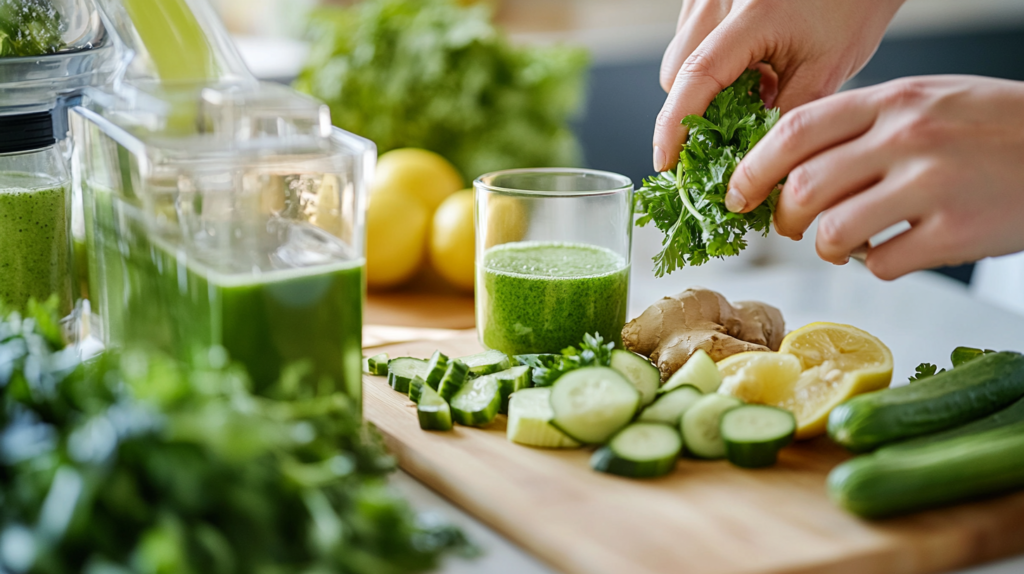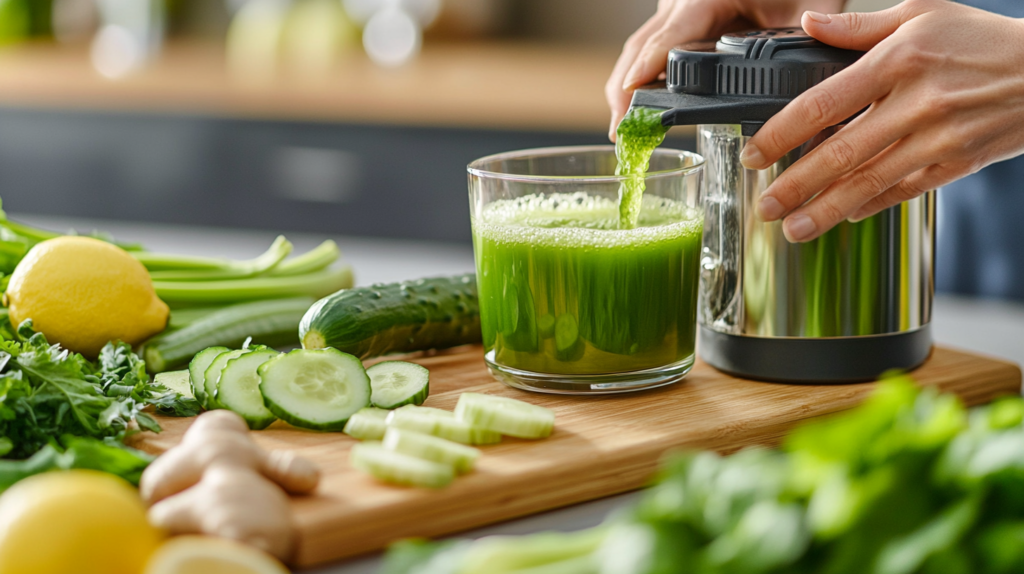If you are looking for a natural and effective way to shed excess weight, juicing is one of the best options. Fresh juices provide essential nutrients while keeping calorie intake low, helping you burn fat, speed up metabolism, and detoxify your body.
This guide will walk you through the best weight-loss juice recipes, the most effective ingredients, and expert tips to help you get started on your juicing journey.
Table of contents
- Introduction
- Best Ingredients for Weight Loss Juices
- Top Juice Recipes for Weight Loss
- How to Use Juicing for Effective Weight Loss
- Common Mistakes and How to Avoid Them
- Additional Tips for Maximizing Weight Loss with Juicing
- Frequently Asked Questions (FAQ)
- Discover More Healthy and Delicious Recipes
- Conclusion
Introduction
How Juicing Supports Weight Loss
Juicing is an excellent addition to a healthy weight loss plan because it provides low-calorie, high-nutrient beverages that keep you full and energized. But how exactly does juicing help with weight loss?
- Boosts Metabolism – Ingredients like ginger, lemon, and green tea naturally enhance fat-burning processes.
- Reduces Hunger – Juices are packed with fiber (when blended) and essential nutrients, which help curb cravings.
- Eliminates Toxins – Juicing supports liver function, helping your body break down fats more efficiently.
- Keeps You Hydrated – Many people mistake thirst for hunger. Juicing ensures you stay hydrated and avoid unnecessary snacking.
“Juicing is like giving your body a reset button—it helps flush out toxins, nourish your cells, and support weight loss in a natural way.”
Benefits of Drinking Fresh Juice for Fat Loss
Juicing is not just about losing weight; it is about feeling healthier and more energized. Here are some of the best benefits:
- Low in Calories, High in Nutrients – Provides essential vitamins and minerals without extra calories.
- Better Digestion – Fresh juices cleanse your gut and help prevent bloating.
- Improved Skin Health – Antioxidants from fruits and vegetables help promote a natural glow.
- Increased Energy Levels – Provides a natural boost without relying on caffeine or processed sugars.
- No Processed Sugars – Eliminates unhealthy store-bought drinks and sodas.
H3: Who Can Benefit from Weight Loss Juicing?
Juicing is beneficial for almost everyone, but it is especially helpful if:
- You struggle with bloating and sluggish digestion.
- You want a natural way to reduce cravings.
- You are looking for an easy way to eat more fruits and vegetables.
- You want to jumpstart a weight loss journey with healthy habits.

Best Ingredients for Weight Loss Juices
The secret to effective weight-loss-friendly juices is choosing the right ingredients. Not all fruits and vegetables support fat burning, so it is important to pick the best ones.
Low-Calorie Fruits for Natural Sweetness
Fruits add natural sweetness without artificial sugars or extra calories. However, some fruits are better than others for weight loss.
- Green Apples – Low in sugar but full of fiber to keep you full.
- Grapefruit – Packed with fat-burning enzymes and aids digestion.
- Berries (Blueberries, Strawberries, Raspberries) – High in antioxidants and low in sugar.
- Lemon & Lime – Boost metabolism and support liver detoxification.
- Watermelon – Hydrating and low in calories.
“Fruits add a delicious natural sweetness without the need for processed sugars—making your juice both healthy and tasty.”
Fat-Burning Vegetables to Include
Vegetables are essential in any weight-loss juice recipe because they are low in calories and high in fiber.
- Spinach & Kale – Packed with vitamins and support digestion.
- Cucumber – Keeps you hydrated and helps flush out toxins.
- Carrots – Naturally sweet, full of beta-carotene, and great for metabolism.
- Celery – A natural diuretic that reduces water retention.
- Beets – Boost circulation and liver function.
Herbs and Spices That Speed Up Metabolism
Some ingredients do not just add flavor; they actively help burn fat.
- Ginger – Speeds up digestion and calorie burning.
- Turmeric – Reduces inflammation and supports liver detoxification.
- Cinnamon – Balances blood sugar and reduces cravings.
- Mint – Aids digestion and refreshes the body.
Best Liquid Bases for Weight Loss Juices
Instead of adding sugary fruit juice, use these healthy liquid bases:
- Coconut Water – Hydrating and full of electrolytes.
- Green Tea – Boosts metabolism naturally.
- Aloe Vera Juice – Supports digestion and detoxification.
- Plain Water – The simplest and purest option.
“The right liquid base ensures your juice is not just refreshing but also supports fat loss.”
Top Juice Recipes for Weight Loss
Now, let’s get to the best part—making delicious, fat-burning juices. These recipes are simple, effective, and easy to prepare.
Green Fat-Burning Detox Juice
This juice is full of fiber and metabolism-boosting ingredients to help you shed extra weight.
Ingredients:
- 1 cup spinach
- ½ cucumber
- 1 green apple
- 1 celery stalk
- ½ lemon (juiced)
- 1-inch ginger root
- 1 cup coconut water
Instructions:
- Wash all ingredients thoroughly.
- Blend or juice everything together.
- Serve immediately for maximum nutrients.
Citrus Metabolism-Boosting Juice
This juice refreshes your body while increasing calorie burn.
Ingredients:
- 1 grapefruit (peeled)
- 1 orange (peeled)
- ½ lemon (juiced)
- 1-inch ginger root
- ½ teaspoon turmeric
- 1 cup water
Instructions:
- Juice all ingredients together.
- Stir and serve fresh.
Belly Fat Burner Carrot Juice
Carrots are low in calories but packed with fiber, making them great for digestion.
Ingredients:
- 3 large carrots
- 1 apple
- ½ inch ginger
- ½ lemon (juiced)
Instructions:
- Juice all ingredients together.
- Stir and enjoy.
Refreshing Cucumber and Mint Juice
A cool, hydrating juice that helps with digestion and bloating.
Ingredients:
- 1 cucumber
- ½ lemon
- 4-5 mint leaves
- 1 cup water
Instructions:
- Blend or juice everything together.
- Serve chilled.
“Juicing is about balance—finding the right mix of flavors that fuel your body while keeping it light and refreshing.”

How to Use Juicing for Effective Weight Loss
Drinking fresh juice can help with weight loss, but it is important to use it correctly. Simply adding juice to your diet without considering portion sizes, ingredients, or meal balance may not give you the results you want. Let’s go over the best practices for when, how often, and how to include juices in your weight loss plan to maximize results.
Best Times to Drink Juice for Maximum Benefits
When you drink juice plays a role in how it affects your body. Here are the best times to consume juice to support weight loss:
- Morning on an Empty Stomach – Drinking juice first thing in the morning kickstarts digestion, hydrates the body, and provides an energy boost.
- Before a Workout – A juice with citrus, ginger, and green apple provides a light energy boost without feeling too heavy.
- Between Meals as a Snack – A vegetable-heavy juice helps keep cravings under control and prevents overeating.
- Before Meals – Drinking a fresh low-sugar juice 20-30 minutes before a meal can help reduce appetite and portion sizes.
- After a Workout – A juice with electrolytes and antioxidants helps with recovery and hydration.
“Drinking juice at the right time can improve digestion, control cravings, and support your metabolism.”
How Often Should You Drink Juice for Weight Loss?
How often you drink juice depends on your weight loss goals and overall diet. Here is a guide to help:
- Daily Juicing – Drinking one juice per day is a great way to add nutrients while keeping calories low.
- Short-Term Juice Cleanse (1-3 Days) – A one to three-day juice cleanse can help reset digestion, but should be done with careful planning.
- Long-Term Juicing (Lifestyle Change) – Replacing one meal per day with a healthy juice can help with sustainable weight loss.
A common mistake is replacing all meals with juice for an extended period, which can lead to nutrient deficiencies, muscle loss, and fatigue.
Should You Replace Meals with Juice?
Juicing is nutrient-dense, but it lacks essential elements like protein and healthy fats that keep you full and energized.
Best approach:
- Use juices as supplements, not full meal replacements.
- If replacing a meal, choose a smoothie with added protein, nuts, or seeds instead of pure juice.
- Pair juices with balanced meals that include lean protein, fiber, and healthy fats.
“Juicing should complement your meals, not completely replace them. A balanced diet leads to better long-term results.”
Juicing vs. Smoothies: Which is Better for Weight Loss?
Both juices and smoothies can support weight loss, but they work in different ways.
| Factor | Juices | Smoothies |
|---|---|---|
| Nutrient Absorption | Absorbed quickly, easy on digestion | Slower absorption due to fiber |
| Satiety (Fullness) | Less filling due to lack of fiber | More filling because fiber is retained |
| Sugar Content | Can be high if too much fruit is used | Balanced sugar release due to fiber |
| Best For | Quick nutrient boost, hydration | Meal replacement, sustained energy |
Which one should you choose?
- If you want quick absorption, go for juice.
- If you need something filling, go for a smoothie.
“Juices are great for hydration and quick nutrition, but smoothies keep you full longer—choose based on your needs.”
Common Mistakes and How to Avoid Them
Juicing is simple, but some common mistakes can slow down weight loss progress. Here are the top errors and how to fix them.
Using Too Much Fruit and High-Sugar Ingredients
Many people overload their juices with fruit, thinking it is healthy. However, fruit-based juices can cause blood sugar spikes and energy crashes.
How to Fix It:
- Use at least 70% vegetables and only 30% fruit to balance sugar levels.
- Avoid high-sugar fruits like bananas, grapes, and mangos in juices.
- Choose low-sugar fruits like green apples, berries, and citrus.
Not Getting Enough Fiber While Juicing
Since juicing removes fiber, you might miss out on an important part of digestion. Fiber keeps you full longer and supports gut health.
How to Fix It:
- Pair juices with fiber-rich meals like whole grains, nuts, or salads.
- Occasionally blend your ingredients instead of juicing to retain fiber.
- Add chia seeds or flaxseeds to your meals to increase fiber intake.
“Juices deliver nutrients fast, but fiber keeps digestion strong—don’t forget to eat fiber-rich foods alongside juicing.”
Relying Only on Juice Without a Balanced Diet
Some people believe that drinking only juice for weeks will help them lose weight faster. However, this can lead to muscle loss, fatigue, and slowed metabolism.
How to Fix It:
- Use juices to complement a balanced diet, not replace it.
- Eat lean proteins, whole grains, and vegetables alongside juicing.
- Follow a long-term sustainable eating plan for best results.
Choosing Store-Bought Juice Instead of Fresh Juice
Many bottled juices claim to be healthy, but they often contain added sugars, preservatives, and fewer nutrients than fresh juice.
How to Fix It:
- Always choose freshly made juice instead of processed options.
- If buying store-bought juice, check the ingredients for no added sugars or preservatives.
- Look for cold-pressed juices, as they retain more nutrients than heat-pasteurized ones.
“Fresh juice is always the better choice—maximize nutrients by making your own.”

Additional Tips for Maximizing Weight Loss with Juicing
Juicing is just one part of a healthy lifestyle. To see real results, pair it with other smart habits.
Combining Juicing with a Healthy Diet Plan
- Focus on whole foods like lean proteins, vegetables, and healthy fats.
- Avoid processed foods and refined sugars, which slow down weight loss.
- Stick to balanced meals, using juice as a supplement.
The Importance of Exercise While Juicing
Juicing helps detoxify and boost metabolism, but exercise burns calories and builds muscle.
- Engage in daily movement, such as walking or yoga.
- Use pre-workout juices with citrus and ginger for energy.
- After a workout, choose a protein-rich meal to aid muscle recovery.
“Juicing and exercise work together—while one nourishes, the other burns fat.”
Staying Hydrated and Drinking Enough Water
Juicing hydrates the body, but you still need water for full hydration.
- Drink at least 8 glasses of water per day.
- Add herbal teas or infused water for variety.
- Avoid sugary drinks like sodas or artificial juices.
Best Ways to Store Fresh Juice for Maximum Nutritio
Fresh juices lose nutrients quickly, so proper storage is important.
- Drink juice immediately for the highest nutrient content.
- If storing, use an airtight glass jar and refrigerate for 24-48 hours.
- Keep juice away from direct sunlight to preserve vitamins.
Frequently Asked Questions (FAQ)
Juicing for weight loss is a great addition to a healthy lifestyle, but many people have questions about how to do it properly. Here are answers to the most commonly asked questions.
Can You Lose Weight by Drinking Juice Alone?
Yes, but it is not recommended to rely only on juice for long-term weight loss.
- Short-Term: A 1-3 day juice cleanse can help jumpstart weight loss by reducing bloating and improving digestion.
- Long-Term: Sustainable weight loss requires balanced meals with fiber, protein, and healthy fats. Juicing should be a supplement, not the only source of nutrition.
“Juicing is a great tool, but lasting results come from a balanced diet and active lifestyle.”
How Long Does It Take to See Results?
Weight loss results from juicing vary based on diet, exercise, and metabolism.
- After 1-3 Days: You may notice less bloating and improved digestion.
- After 1-2 Weeks: If combined with a healthy diet and exercise, you may see noticeable fat loss.
- Long-Term: The best results come from consistent healthy eating habits and regular activity.
For sustainable weight loss, focus on gradual progress rather than quick fixes.
What Are the Side Effects of Juicing?
Juicing is safe for most people, but some may experience mild side effects, especially when replacing all meals with juice.
Common side effects include:
- Hunger & Fatigue: Due to a lack of protein and fiber.
- Digestive Issues: A sudden increase in raw vegetables can cause bloating.
- Blood Sugar Spikes: Too much fruit juice may raise blood sugar levels.
How to Prevent Side Effects:
- Keep juices vegetable-heavy and low in fruit to control sugar.
- Drink plenty of water to avoid dehydration.
- Pair juicing with balanced meals to avoid energy crashes.
“Listen to your body—if you feel weak or tired, adjust your juicing plan for better balance.”
What is the Best Juicer for Weight Loss Juicing?
Choosing the right juicer depends on your budget, time, and needs.
- Centrifugal Juicers: Fast and affordable, but they produce heat, which may reduce nutrients.
- Masticating (Cold-Press) Juicers: Extract more juice while preserving nutrients, but they are slower and more expensive.
- Blenders (For Smoothies): Keep all fiber intact, making juices more filling.
For the best weight-loss-friendly juices, a masticating juicer is ideal because it preserves nutrients while producing a high-quality juice.
“Investing in a good juicer ensures you get the most nutrients and benefits from your ingredients.”
Discover More Healthy and Delicious Recipes
If you enjoyed these Juice Recipes for Weight Loss, here are more nutritious and refreshing options to support your health journey:
- Looking for a vitamin-rich drink? Try this Carrot Juice Recipe: A Refreshing and Nutritious Drink for Every Day to boost immunity and digestion.
- Want a high-protein breakfast option? These Salmon Breakfast Recipes: Start Your Day with Flavor and Nutrition provide a balanced and satisfying start to your morning.
- Craving a sweet treat without guilt? Check out Healthy Desserts: Delicious, Guilt-Free Sweets for Every Occasion for naturally sweet and nutritious desserts.
- Love homemade, wholesome bread? Try The Ultimate Vegan Bread Recipe: Easy, Delicious, and Homemade for a plant-based and nutritious alternative.
- Looking to add more superfoods to your diet? Purple Sweet Potato Recipes: Delicious and Nutritious Ways to Enjoy This Superfood is packed with antioxidants and fiber.
For more healthy and delicious recipes, visit Call Me Recipes and discover new ways to stay fit and nourished!
Conclusion
Juicing is an excellent way to boost metabolism, burn fat, and improve overall health. Whether you want a quick detox, a daily health boost, or a long-term habit, the key is using the right ingredients and following a balanced approach.
Key Takeaways for Successful Juicing:
Choose low-sugar, high-vegetable juices to avoid blood sugar spikes.
Drink juices at the right times (morning, pre-meal, or post-workout).
Do not rely only on juice—pair it with whole foods for the best results.
Avoid common mistakes like too much fruit, dehydration, or extreme fasting.
Store fresh juice properly and consume it within 24-48 hours for maximum nutrition.
By incorporating one juice a day, staying active, and maintaining a healthy diet, you can achieve long-term weight loss and better overall health.
“Juicing is not just about losing weight—it’s about nourishing your body and feeling your best every day.”

